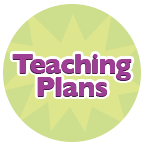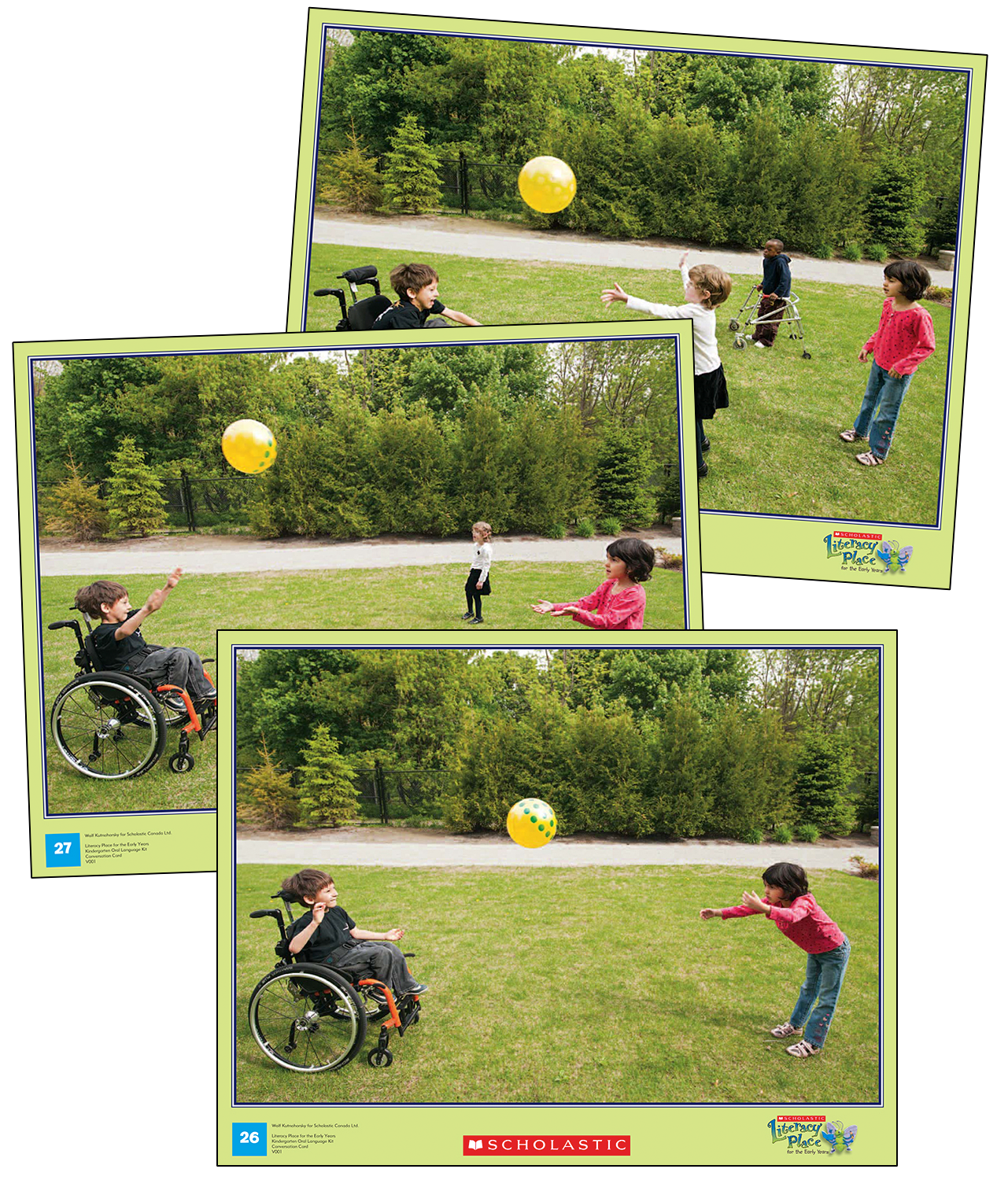Summary: At first, two children are playing catch. Another girl enters the scene and watches the children playing and is invited to join in. Later, another child enters the scene and he watches the three children play catch.
Oral Language Teaching Strategy: Role Play – Explore Other People’s Viewpoints Use role-playing to stimulate social language development and problem solving.
Time: one 30-minute lesson or two 15-minute lessons
Materials: Sequence Cards #26, 27, 28
Grouping: whole class or small group
Assessment:
Kindergarten Oral Language Assessment Scale
FOCUSING ON THE PICTURE
[Inferring/analyzing]-
Today we are going to look at three pictures. These pictures are connected and tell a story. As you look closely at the pictures, think about the order they should go in. What do you think the pictures are trying to tell us?
Display the three cards prominently, in random order, so all students can see. Provide ample time for students to analyze the pictures, providing prompts to deepen their observations.
- Have students turn to an elbow-partner and discuss what they think is happening in the pictures. Have the partners decide on an order for the pictures.
-
Offer prompts to stimulate discussion:
- Who do you think the children in these pictures are? Should we
give them names? - Where do you think they are? Why?
- How do you think the children know each other?
- What is happening in each picture?
- What clues can we use to figure out what is happening in these pictures?
- Who do you think the children in these pictures are? Should we
-
Oral and Alicia put the pictures in the order that they think the events happened. What reasons do you think they have for placing the cards in this order? Is this the same order in which you would have placed the pictures?
Provide time for discussion and then ask one pair of students to arrange the cards in their agreed-upon order. Then have the rest of the class try to figure out the reasons for putting them in this order.
-
Invite the pair of students to share their thinking for the order of the cards. If any other pair of students has a different order, have them rearrange the cards and explain their thinking.
-
As a group, decide on an appropriate order of the sequence cards and have students share their reasoning.
GOING DEEPER
[Inferring/evaluating]Have you ever wanted to join a game other people were playing? How did you feel? Did they let you join the game?
Have students act out the roles in the sequence cards to help them understand how the people may be feeling.
-
Offer open-ended prompts that focus the students on the emotions and interactions portrayed:
- What is happening in the first sequence card? the second sequence card? Is the girl just watching or does she want to be part of the game?
- Look at the third sequence card. Did the girl just start playing or did they include her in their game of catch? Why do you think so? Do you think they will include the new boy in their game? Why do you think so?
- Let’s take a closer look at the boy in the wheelchair in all three sequence cards. How is he feeling in the first sequence card? the second sequence card? the third sequence card? What clues tell you this? Look closely at the boy’s face. What do you see?
- What is happening in the third sequence card? Why do you think the girl with the white shirt is now playing ball with the boy? Why is she closer than the other girl in the pink shirt? How do you think the girl in the pink shirt is feeling in the third sequence card? What changes do you notice between the pictures?
- What do you think the girl in the pink shirt would say after this happened? How would you feel in this situation? What would you say?
The person who took these pictures wanted us to see a story about including others. Do you see this? What does including others mean?
Encourage students to put themselves in the position of the girl wearing the pink shirt. Ask for volunteers to role play one of the girls. Have them act out what they think the girl is saying.- Choose another situation about including others and invite two students to role play with you.
We are going to pretend that I am a new student who has just come to our class. What would you do to include me? How do you think a new student might feel?
Teaching Tip: You may want to discuss in depth what including others means. Some children’s books about this are: My Best Friend Will by Jamie Lowell and Tara Tuchel (about autism) and Don’t Laugh at Me by Allan Shamblin and Steve Seskin (Reading Rainbow Series about inclusion).
You may conclude the lesson at this point and do the second part on the next day, or you may decide to continue and do Connecting and Predicting as part of the first lesson.
CONNECTING
Teaching Tip: If you decide to do Connecting and Predicting on the second day, begin your lesson by reviewing the sequence cards with the students.
[Making connections]- Ask students to connect their personal experiences with the children in these pictures. Prompts might include:
- Do think it is important to make everyone feel included? Why?
- How does it feel to be left out? Would you like to feel this way?
- If you don’t want to be left out, how should you treat others?
- How might the children in these pictures have made everyone feel included?
Have you ever felt left out? How did it feel?
Offer specific prompts that fit the discussion you have had with the group.
PREDICTING
[Predicting]What do you think will happen next? Why do you think this?
Ask students to think about what might happen next after Sequence Card # 28.- Choose one possible scenario and have students act it out in partners. Then discuss how role play can be an excellent strategy to help us understand how someone else is feeling. (You may wish to introduce the word ‘empathy.’)
LESSON EXTENSIONS
-
Create a shared writing chart with ideas of how we can include others and make everyone feel welcome. Place it prominently in the classroom.
-
Sledge hockey is a paralympic sport and can be quite easily simulated in the gym. Have students sit on a chair with wheels or a scooter and tell them they cannot use their feet. Using two hockey sticks to propel themselves, children must try to move a short distance and then shoot a puck. Students quickly discover that it is not easy to move without the use of their feet.
FOLLOW-UP IN CENTRES
- Provide students with a variety of puppets and Sequence Cards # 26, 27 and 28. Students can retell the story, and then re-enact the predictions they made about what will happen following the image on the last sequence card.
- From scrap materials, have students create different pieces of equipment that help people move (e.g., wheelchair, walker, crutches, etc.). Recreate these equipment pieces large enough for students to use with the puppets.

